 |
Soil & Water
Research Areas:
Road Erosion
Fire Effects
Disturbed Forests
Upland Watersheds
Slope Stability
Erosion Modeling
Climate Modeling
Project Leader:
William J. Elliot
Last Revised:
|
 * Printer Friendly Version (PDF)
* Printer Friendly Version (PDF)
|
 |
 |
 |
Measuring Hillslope Erosion with Silt Fences
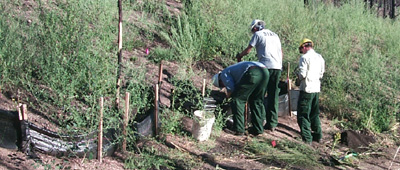
Cleaning out sediment first year, 2002 Hayman fire, Pike-San Isabel National Forest.
|
Measuring hillslope erosion has historically been a costly, time-consuming
practice. An easy to install low-cost technique using silt
fences (geotextile fabric) and tipping bucket rain gauges
to measure onsite hillslope erosion was developed and tested.
Equipment requirements, installation procedures, statistical
design, and analysis methods for measuring hillslope erosion
are discussed. The use of silt fences is versatile; various
plot sizes can be used to measure hillslope erosion in different
settings and to determine effectiveness of various treatments
or practices. Silt fences are installed by making a sediment
trap facing upslope such that runoff cannot go around the
ends of the silt fence. The silt fence is folded to form a
pocket for the sediment to settle on and reduce the possibility
of sediment undermining the silt fence. Cleaning out and weighing
the accumulated sediment in the field can be accomplished
with a portable hanging or platform scale at various time
intervals depending on the necessary degree of detail in the
measurement of erosion (that is, after every storm, quarterly,
or seasonally). Silt fences combined with a tipping bucket
rain gauge provide an easy, low-cost method to quantify precipitation/hillslope
erosion relationships. Trap efficiency of the silt fences
are greater than 90 percent efficient, thus making them suitable
to estimate hillslope erosion.
|
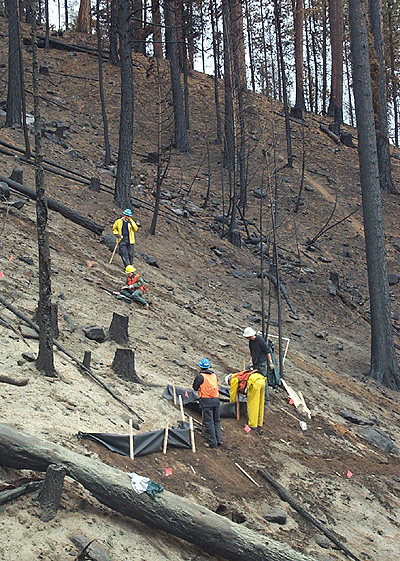
|
| |
Installing silt fences to monitor the effectiveness of hydromulch after
the 2003 Myrtle Creek fire, Idaho Panhandle National Forest.
|
|
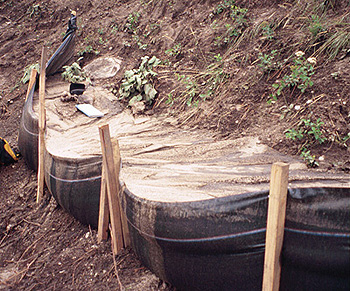 Full fence after the 2000 Bitterroot Valley fires.
Full fence after the 2000 Bitterroot Valley fires.
|
Key reference for silt fence installation and analysis:
Interactive spreadsheet files for silt fence statistical analysis in Microsoft Excel format:
|
|
Other publications regarding silt fence usage and data collection:

Cleaning sediment after the 1998 North-25 fire in the Wenatchee National forest.
|
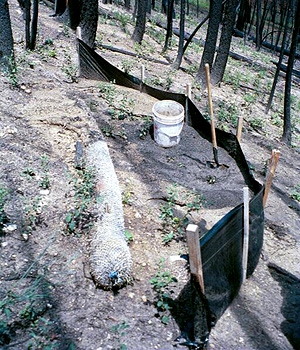
Comparing the effectiveness of a straw waddle after the 2000 Bitterroot Valley fires.
|
|
|
Requester/Organization/Location
|
Questions Being Studied
|
Date
|
|
|
Hot Creek fire, Boise NF
|
Postfire treatment effectiveness--flow check
|
2003
|
|
Myrtle Fire, Idaho Panhandle NF
|
Postfire treatment effectiveness--hydromulch
|
2003
|
|
Roberts Fire, Flathead NF
|
Postfire treatment effectiveness--surfactants
|
2003
|
|
Hayman Fire, Pike-San Isabel NF
|
Postfire treatment effectiveness--wood straw
|
2002
|
|
Rodeo-Chediski Fire
|
|
|
F. Sandberg, Sho Lo High School
|
Postifre treatment effectiveness
|
2002
|
|
S. Moore, BLM-Oregon
|
Postfire treatment effectiveness
|
2002
|
|
Dr. S. Wondzell, OSU
|
Hillslope erosion from Rx fire--JFSP funded
|
2002
|
|
L. Wasniewski, Deschutes NF
|
Monitoring BAER treatment effectiveness and salvaging logging effects
|
2002
|
|
E. Grote, USGS-BRD, Moab, UT
|
Measure canyon road traffic effects
|
2001
|
C. Hermandorfer, Uinta NF
W. Christian
|
Hillslope erosion from various burn severities
|
2001
|
|
Dr. F. Smith, Watershed Science, CSU
|
Hillslope erosion from various burn severities
|
2000
|
|
G. Orton, Umpqua NF
|
Hillslope erosion from various burn severities
|
2000
|
|
Dr. J. McIvers, PNW
|
Salvage logging effects
|
2000
|
|
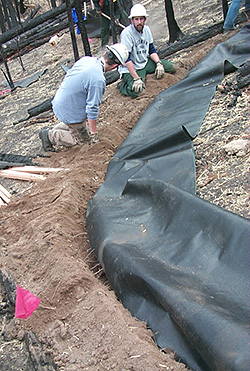
|

Silt fence installation and completion, after the 2003 Hot Creek fire, James Creek, Atlanta -- comparing to the effectiveness of straw mulch.
|
|

|
|

